- Offensive Techniques & Strategies
Raising Your Level of Passing
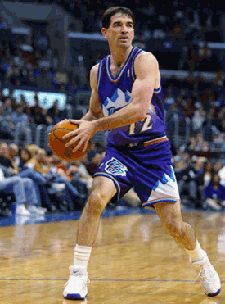

What level of passer are you?
Level One.
Throws the ball to an area just to get rid of it. Common among beginning players.
Level Two.
Just throws the ball toward a teammate no matter if they are ready to receive it or not. This is why players get hit by the ball during practice when just standing around.
Level Three. Surgeon.
Passes to a specific target (hand or finger). Leads receivers into good shots. Rarely throws the ball away.
Level Four. Magician.
A rare individual that can create open shots for teammates. Makes no look passes. Never throws the ball away.
The ability to move the basketball and hit the open man is a characteristic found in all great players and teams. In order to perfect this ability to its utmost, players must first utilize and master the fundamental principles of passing.
San Antonio Spurs Passing - The Beautiful Game (6:20)

Ten Fundamental Principles of Passing
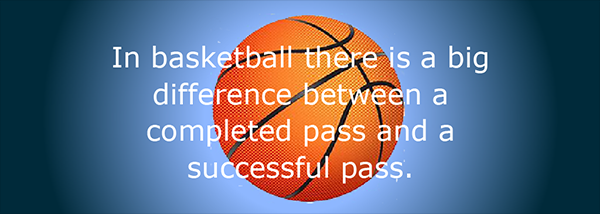
1. Anticipate
Read the defense and know where to pass before receiving the ball. Outstanding basketball players have the ability to anticipate where to pass the basketball. This is why professional players need very little team pattern to create good scoring opportunities for their teammates.
2. Maintain a proper spacing
Most passes should be made within a 12' to 15' distance. This spacing spreads the defense and allows for quick, accurate passing. Passes beyond 15' carry a high risk of interception. Never throw directly at a receiver moving away from you. Always lead the receiver to the basket on lob and baseball passes.
3. Close the Distance
When the defender is playing off, close the distance with a dribble to less than 3 feet. The closer the defender plays, the less time they have to read and react to the passer's movements. Dribble penetration will also force the defender to defend against the drive and eliminates their playing of the passing lane.

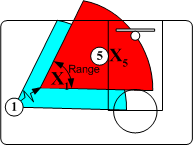
When defenders anticipate and play off in the passing lane, not only are they able to concentrate on intercepting or deflecting the pass, but the range that they are able to cover increases.
When the passer closes the distance with dribble penetration against a defender playing off in the passing lane, it forces the defender to defend against the drive and eliminates their playing of the passing lane making it easier to complete the pass.
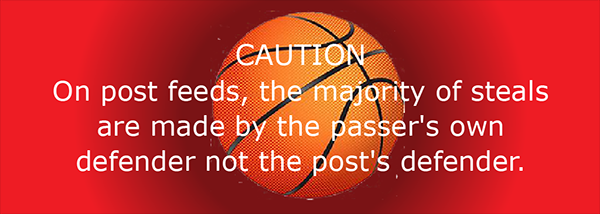
4. Look off the receiver.
Use split vision to see the passing lane and receiver. Avoid telegraphing pass by turning head and looking directly at the receiver. Use quick wrist action for all passes. Eliminate all unnecessary movements like winding up and stepping with the pass.
5. Pass through the defense.
Avoid passing over or around the defender. Pass fake in opposite direction. Watch the defender's hands and make a quick, accurate pass away from them. When the defender plays with his/her hands up, fake high and pass under their arm pit. When the defender holds his/her down, fake low and pass over their shoulder between their arm and head.
6. Read and pass away from the receiver's defender.
Recognize how the defender is playing the receiver and pass to the opposite side. The receiver has the responsibility to "shape up" in such a manner that he presents a good target. They must protect the passing lane by assuming a low stance with the foot nearest to the defender forward between the defender and the ball.
Passing: Line of Deployment

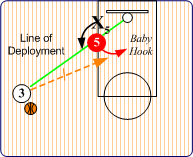
When the defender assumes a pass denial position on the top side, the pass should be made to the receiver's baseline hand.
When the defender plays on the baseline side of the receiver, the pass should be made to receiver's top hand.
By recognizing where the defender is playing the receiver in relation to the "Line of Deployment" allows the passer to lead the receiver into a good shot.
7. Move the ball
The ability to make the good quick, strong pass cannot be over emphasized. The basketball has to be moved. A player should be able to successfully execute his play (pass, shot, drive) within three seconds after receiving the ball. The ability to move the ball separates the good players from the mediocre ones and the good ball clubs from the poor ones.
8. Pass and move
Passer must move a specific purpose after executing a pass. Each movement should result in a screen, a shot, rebound position, a fake or clear. Standing and watching after making pass is a major fault of the poor player.
9. Develop pride in your passes
Work hard to perfect all types of passes. Be clever, not fancy. The clever passer will receive praise while the fancy one will be ridiculed.
10. Never pass to a receiver that does not call for or wants the ball.
A vast majority of bad pass turnovers are the result of the receiver not ready to receive the ball. Receivers must have their hands up and call for the ball either verbally or non-verbally. It is a good rule to never pass to a receiver, even if they are standing alone under the basket, with their hands down.
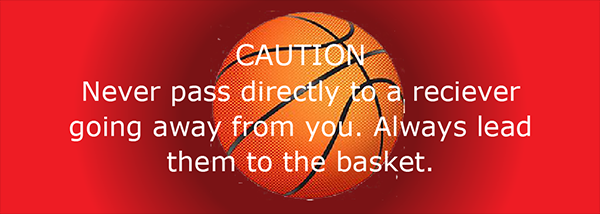
Return to Player Development - Click Here
Return to Defensive Strategies - Click Here
Return to HoopTactics - Click Here
© 2026 HoopTactics All Rights Reserved.
